Japan
Wood Products Prices
Dollar Exchange Rates of 10th
May
2023
Japan Yen 134.40
Reports From Japan
Corona reclassified to same level as
seasonal influenza
As of 8 May the Japanese government categorised the corona virus at
the same risk level as seasonal influenza. This means the government will no
longer restrict people’s movements and everyone will be free to make
decisions on protection. Under the new category, Covid-19 vaccinations will
continue to be free through this fiscal year as infections could continue
spreading.
See:
https://www3.nhk.or.jp/nhkworld/en/news/20230507_13/
Wage increases made to hold onto staff
A Finance Ministry survey showed over 60% of companies in Japan
have raised or plan to raise base pay in fiscal 2023 as they struggle to
find and keep skilled workers. Most of the companies saying they will raise
wages were in the manufacturing sector with almost 70% saying they have, or
will, raise wages this year compared to 52% last year.
The survey asked the reasons for raising wages and over 80% said this is to
motivate employees, improve their labour conditions and encourage them to
stay with the company. Other respondents said they did so"to respond to
rising prices”.
See:
https://english.kyodonews.net/news/2023/05/e40b323fe662-62-of-japan-firms-raise-base-pay-in-fy-2023-amid-inflation.html
Business sentiment at lowest level in two years
A Bank of Japan survey showed that in the first quarter of this
year business sentiment dropped to the lowest level in more than two years
as weak global growth was viewed as a risk to the export-reliant economy.
The sentiment index for big manufacturers fell in the first quarter, the
fifth straight quarter of decline and the worst since December 2020. In
contrast, mood in the service sector recovered in the first quarter as
border controls were eased and the easing of covid restrictions opened the
way for a rebound in tourism and personal consumption.
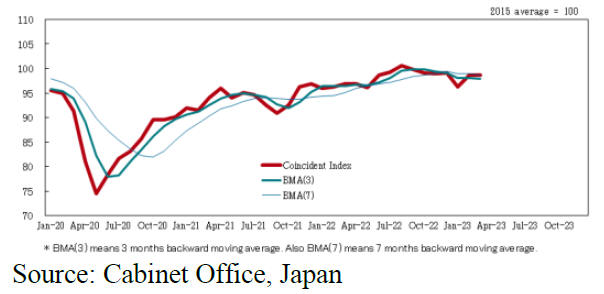
Modest recovery in consumer sentiment
The modest recovery in consumer sentiment since January this year
continued in April with household’s expectations of inflation coming down
slightly. The positive consumption data has been considered as a possible
trigger for the Bank of Japan to adopt a more normal monetary policy.
Behind the more positive sentiment was the wage increases agreed at the
start of the year, but inflation and price inceases for basics have whittled
away most of the wage hike gains.
The government kept its assessment of consumer confidence unchanged as the
improvement in April was small. The rising cost of living could result in a
slowdown in consumer spending later this year as the Bank of Japan has said
consumers will continue to face more inflationary pressures.
See:
https://www.japantimes.co.jp/news/2022/05/02/business/april-consumer-confidence-index-up/
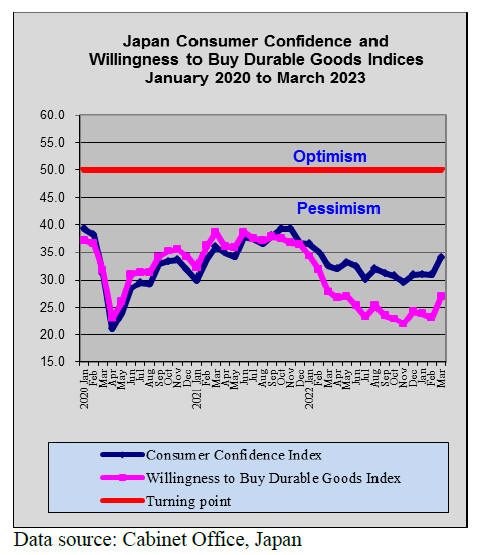
Address economic fundamentals to stabiles
yen
Late last year the domestic newspaper The Mainichi published an
editorial on the yen exchange rate and the sentiment expressed back in
October 2022 is just as valid today.
The Maninchi said the yen’s rapid depreciation is
not just the result of the US dollar rising but also suggests currency
traders are "selling off Japan" as the economy weakens. The Mainichi warns
action is needed.
The yen's depreciation stands out in comparison to other major currencies
which seem to signal a need to address some economic fundamentals. As a
resource poor country Japan depends on imported energy and much of its food
needs and the weak yen has created a record trade deficit.
See:
https://mainichi.jp/english/articles/20221022/p2a/00m/0op/011000c
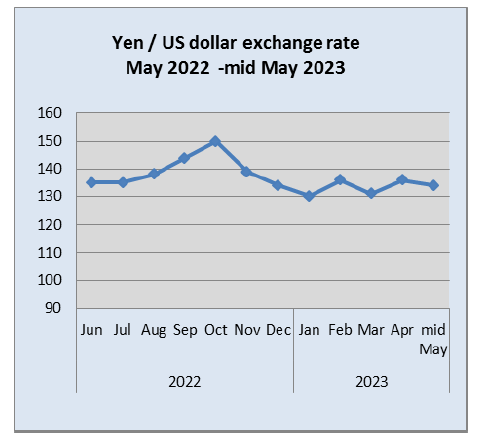
Concept of ‘workation’ promoted
Seven prefectural and 58 municipal governments in rural Japan have
come together to promote the concept of “workation” or telecommuting from
resorts and other vacation spots thus combining work and vacation. The new
group aims to build a business model that involves more than sightseeing but
less than permanent migration.
Getting urbanites to appreciate rural life is expected to lead to migration
growth in these areas and help rural authorities solve problems stemming
from a shrinking population.
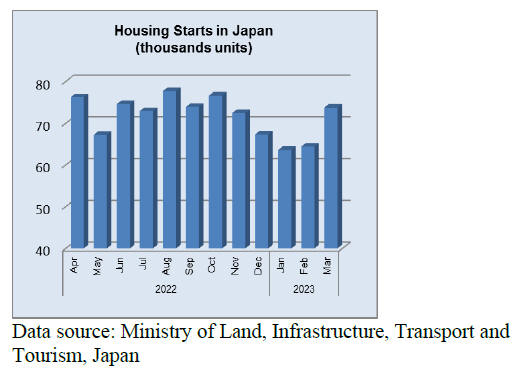
Start-Up offers forest management to private owners
Much of the private forests in Japan are in poor condition but harvesting
and reforestation are beginning to attract attention. A start-up company in
Tanabe, Wakayama Prefecture has begun offering forest management services to
private forest owners and is promoting reforestation of unused land.
The company claims reforestation is attractive to young people from urban
areas as they can work in a natural environment. The company adopted a
flexible work style allowing employees to decide their own shifts and have
second jobs. The company has said the domestic timber industry has long been
in a slump because of low priced timber imports and an increasing area of
forests has been left untended or abandoned after logging.
According to the Forestry Agency only around 30-40% of land logged each year
is replanted. In the five years through fiscal 2018 the cumulative total of
unplanted land was around 2,560 square kilometres. In 2016, the government
designated forestry as a “growth industry” and will introduce a tax of yen
1,000 per taxpayer from fiscal 2024 for subsidies. The government is already
expanding subsidies to forest owners to encourage them to grow trees. A
forest management law of April 2019 allowed municipalities to entrust forest
management to private companies on behalf of owners.
Import update
Assembled wooden flooring imports
Over the past 5 years there has not been such an erratic swing in
the monthly values of assembled flooring imports. Clearly the trading
pattern changed in the first quarter of this year.
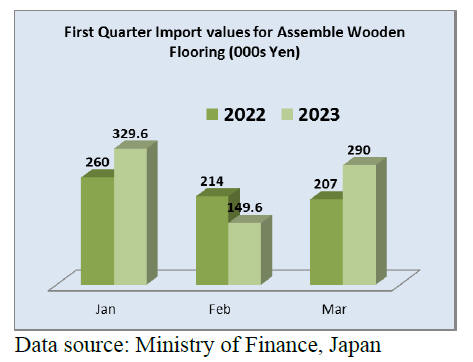
The value of Japan’s imports of assembled wooden
flooring (HS441871-79) in March was up 40% year on year and month on moth
there was a massive 90% rise in the value of imports. The monthly rise in
imports stems from a sharp increase in imports from both China and Vietnam
as in each country full production and export deliveries recovered after the
Spring Festivals.
Three shippers accounted for over 70% of Japan’s imports of assembled
flooring in March, China 50%, up on February and Vietnam 16%. There were no
shipments from Vietnam in February. Other significant shippers in March were
Malaysia contributing 7% to the total value of imports and Thailand
accounting for 5.5%.
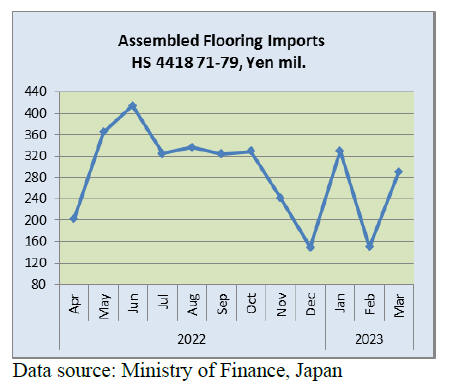
Plywood imports
First quarter 2023 plywood imports were down over 30% compared to
the first quarter of 2022.
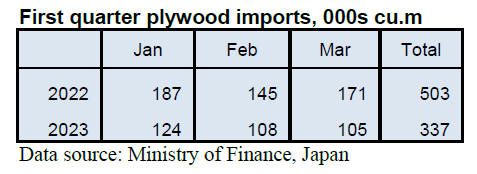
The downward trend in Japan’s plywood imports
continued in March 2023 with both of the main shippers, Malaysia and
Indonesia seeing volumes drop. On the other hand shippers in China and
Vietnam have seen volumes holding steady over the past 12 months.
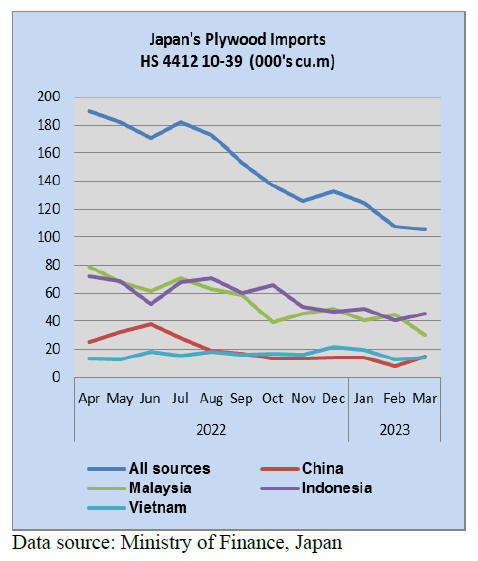
In March this year shipments of plywood from
Malaysia were down around 35% compared to a month earlier with shippers in
Indonesia seeing a slight rise in volumes shipped to Japan.
Plywood shipments to Japan from China picked up in March (doubling compared
to February) bringing shipments back to the average for the past 12 months.
March shipments of plywood from Vietnam rose slightly after the downturn
seen in February.
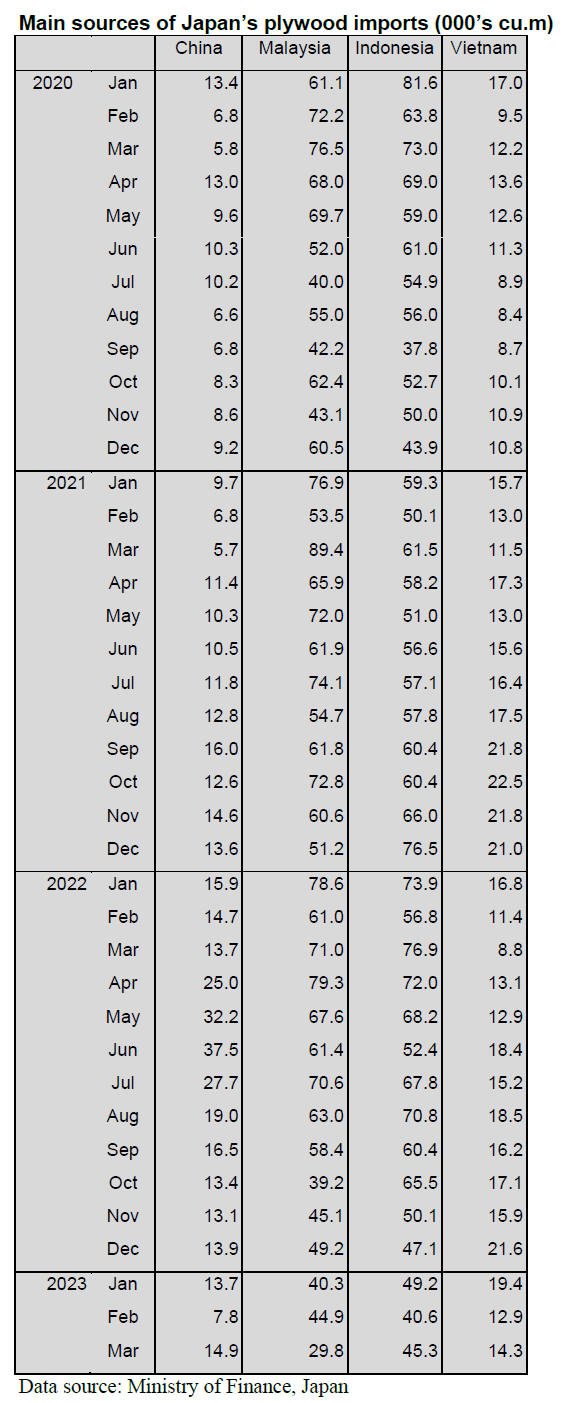
Trade news from the Japan Lumber Reports (JLR)
The Japan Lumber Reports (JLR), a subscription trade journal published every
two weeks in English, is generously allowing the ITTO Tropical Timber Market
Report to reproduce news on the Japanese market precisely as it appears in
the JLR.
For the JLR report please see:
https://jfpj.jp/japan_lumber_reports/
Wood use promotion
There was an announcement about a result of using wood for
buildings of 2022 from The Ministry of Agriculture, Forestry and Fisheries
and other departments. Agreements of using wood for buildings were concluded
with Japanese government for 10 cases and with local government for 60
cases. 15,100 cbms of lumber were used for buildings during October, 2021 to
March, 2023. It was 732 cases.
Plywood
Buyers purchase domestic softwood plywood only for the present use.
The prices of 12mm, 3 x 6 structural softwood plywood are 1,800 – 1,850 yen,
delivered per sheet. This is around 50 yen down from last month. At some
precutting plants, the prices are lower than 1,800 yen.
Plywood companies started reducing production since last October. Total
production during October, 2022 to March, 2023 is 23.6% down from the same
periods last year. Shipment had been sluggish and the inventory increased
until February. However, the shipment exceeded production in March.
Plywood companies in Eastern Japan continue reducing production in May and
the companies took the holiday longer than usual holiday at the beginning of
May. The prices of 12mm 3 x 6 painted plywood for concrete form are 2,000
yen, delivered per sheet. However, a purchase price was around 2,300 yen so
it is hard to get profits.
Some of the reasons are that the future price of painted plywood for
concrete form in overseas decreased to $750, C&F per cbm from $850, C&F per
cbm last year. Also, the import cost decreased around 2,000 yen, C&F per cbm.
145,716 cbms, of imported plywood were received in February, 2023 and this
was 22.9% less than the same month last year. This is nearly 40% down from
the peak in last year. A small amount of imported plywood will be received
until May and the inventory will decline.
Domestic logs and lumber
The prices of domestic lumber and logs have been adjusted. The log
market is getting weak as the prices of domestic lumber fall through the
nation. The prices of domestic lumber in Kanto region had been low until
February and then the prices of domestic lumber in Western Japan also
started to fall in March.
The price competition between laminated whitewood post, laminated cedar post
and solid KD cedar post became intense.
Since there were too much laminated whitewood posts and laminated cedar
posts, the prices were declined for major precutting plants.
The log market in Tohoku region started falling since last autumn. The log
market in Northern Kanto region declined in February, 2023 and in Kyushu
area and Western Japan declined at the end of March through April.
Plywood companies in Tohoku region reduced producing plywood since last
autumn and log demand decreased rapidly. Log demand for plywood companies is
over 30% less than the previous year. Moreover, the production of lumber and
laminated lumber decreased and the log market fell.
In Northern Kanto region, the prices of cedar log plunged to around 12,000
yen from 18,000 yen, delivered per cbm in February to March. The prices of
cedar log stopped declining in April.
In Kyushu region, the prices of cedar and cypress are now around 17,000 yen
in April. The prices had been over 20,000 yen until February.
Production of CLT will rise at Cypress Sunadaya
Cypress Sunadaya Co., Ltd. in Ehime Prefecture estimates that the
product of CLT will be 9,000 cbms in a year. It is doubled volume of the
previous year’s result. The company is the largest cedar lumber and
laminated lumber company in Japan. 30,000 cbms of logs are consumed in a
month.
The CLT production in 2022 was 4,500 cbms. A reason for an increase of
production is that the company does business for World Expo 2025 in Osaka
Kansai. Also, the company introduces a new special machine for producing
large CLT panels in this October.
The production of laminated structural lumber will be 60,000 cbms in a year
and it is 3% up from the previous year’s result. 50,000 cbms of 60,000 cbms
logs will be cypress lumber such as posts, foundations and beams.
Consumption of logs will be 300,000 cbms in a year.
The production of cedar dimensional lumber will be 1,000 cbms from 700 cbms
in a month. The prices of SPF decreased after the woodshock but cedar
dimensional lumber is more popular than SPF. The company purchased four new
dryers and special automatic cutting machines to expand production.
|